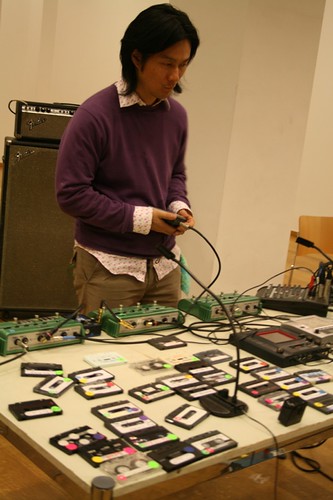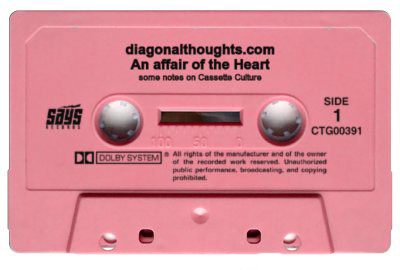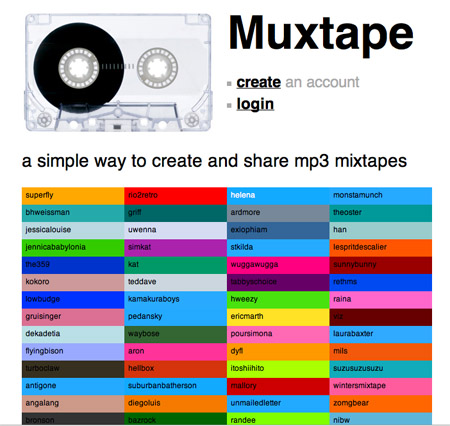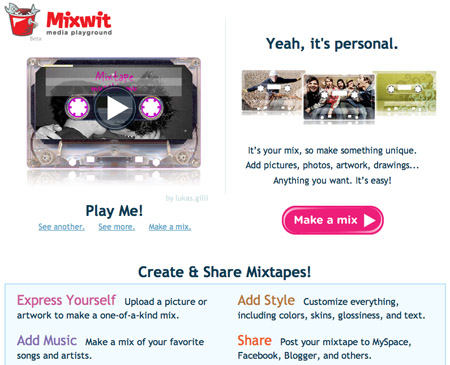“Life ain’t nothing but a good groove / A good mix tape to put you in the right mood.”
— Beastie Boys, ‘Professor Bootie’
When an institution like the Ancienne Belgique here in Brussels devotes a special event to a music-cultural phenomenon, you know the bridge between the ‘underground’ and the ‘mainstream’ has been crossed, whatever that might imply. A concert evening titled CASSETTE CRUSTS ON TAPE TRIPS … (curated by (K-RAA-K)3) is all about cassette culture, with acts that either release their work on tape (like the Brussels based collective Buffle) and/or work with tapes themselves (like Nonhorse and the great Jason Lescalleet). The cassette is back, that’s for sure. Some people obessively hunt for vintage used tapes, on second hand markets, on the streets, in order to manipulate and integrate their sounds in new compositions (like some members of the R.O.T. collective), some use tapes to explore personal and public sonic memory (like Aki Onda, who has been working for over 10 years on his wonderful ‘Cassette Memories’ project, a series of performances and registrations in which he uses his diaristic cassette recordings, collected over many years and extensive travels, to investigate and create spaces that conjure up the essence of memory), and then there are the analogue enthusiasts such as Jérôme Noetinger, Lionel Marchetti and Al Margolis, who proove that there is still plenty of life left in so-called “obsolete” gear. Most of all, there is the re-emergence of cassette labels (in the footsteps of the mythic cassette underground of the 1980’s), which seem to spring up out of the underground like mushrooms, not in the least in Belgium, where labels such as Imvated/Dreamtime Taped Sounds/Bread And Animals or Sloow Tapes are at the heart of the Belgian ‘leftfield’ music scene, with wonderful (limited) releases of Orphan Fairytale, Ignatz, Benjamin Franklin, Silvester Anfang, Buffle as well as many international projects.

(image: Aki Onda before his concert with Ken Jacobs at Bozar. See elsewhere on this blog for more info)
The cassette tape is growing out of the shadows, where it’s been enjoying its near-obsolete retirement-status for the past few years – born in 1963, it had it’s taste of decadent euphoria in the 1980’s (thanks in part to gizmos like the Sony Walkman), but got tired of fighting younger competitors, and was silently waiting for its final deathblow – and is beginning to creep back into the spotlight. Metal-reel cassettes are sold for hundreds of euros via Ebay, tapes are turned into USB sticks, belt buckles, cassette bags, all manner of fashion related retrofits and, also, the your-text-on-a-tape image generator (see image). We’ve never seen so many people wearing a t-shirt depicting cassettes before, with slogans like “I Love Music Tapes”, “8-track is back”, “Vintage Music Addict” or “retro cassette, OLD SKOOL”. What’s more: popular acts like the Notwist and Autechre are releasing their promos on tape. As a way of avoiding the leakage of recordings before the official release date, sure (in the case of The Notwist’s ‘The Devil, You+Me’, scheduled for May, it didn’t work, trust me), but Autechre’s Rob Brown has an explanation that sounds better: “Cassettes hold a significance for us because we grew up swapping tapes in a music sharing culture based on high-speed dubbing, not dial-up speed. Our early promos are on tape. They were the last universal format before everything went digital. People sling cassettes about and you find them on the floor. It’s totally different to the world of vinyl.” But it’s not just a gadget stunt or nostalgy trip: “Tapes give a good sense of the music without loads being shaved off, or the dynamics being altered.”
So yes, it’s about the qualities of analogue sound, the physical matter of tapes, the mechanics of the cassette apparatus, … but perhaps there’s more going on. In 2005 Thurston Moore edited the publication ‘Mix Tape: The Art Of Cassette Culture‘, in which the likes of Lasse Marhaug, Mike Watt, Tom Greenwood of Jackie-O Motherfucker, Jim O’Rourke, Richard Kern, Loren Mazzacane Connors, DJ Spooky, Tony Conrad and Christian Marclay contemplated the role of the cassette tape in their lives, as a portable, inexpensive, durable format which allowed them and all of us to record, mix and listen to music privately. For Moore the mixtape, or any form of music sharing, is an affair of the heart, a sort of “Cultural Love Letters”: “the message of the mixtape might be: I love you. I think about you all the time. Listen to how I feel about you. Or, maybe, I love me. I am a tasteful person who listens to tasty things. This tape tells you all about me…” The main character in Nick Hornby’s ‘High Fidelity’ has similar feelings: “To me, making a tape is like writing a letter — there’s a lot of erasing and rethinking and starting again (…) The making of a good compilation tape is a very subtle art. Many dos and don’ts. First of all, you’re using someone else’s poetry to express how you feel. This is a delicate thing.” The love is in the process, as the initiators of the International Mixtape Project state: “Mixtapes present a strange collision of the cerebral and the emotional, because they most directly satisfy the need, not of the seeker, but of the sender. They are the mixer’s art, while the mixer’s medium is the art of others”.
For Matias Viegener the mixtape is all about the relation between consuming and producing pop culture. “The mix tape is a form of American folk art: predigested cultural artifacts combined with homespun technology and magic marker turn the mix tape into a message in a bottle. I am no mere consumer of pop culture, it says, but also a producer of it. Mix tapes mark the moment of consumer culture in which listeners attained control over what they heard, in what order and at what cost. (…) The mix tape is a list a quotations, a poetic form in fact: the cento is a poem made up of lines pulled from other poems. The new poet collects and remixes. Similarly an operation of taste, it is also cousin to the curious passion of the obsessive collector. Unable to express himself in ‘pure’ art, the collector finds himself on obsessive acquisition. Collecting is strangely hot and cold, passionate and calculating.” Is it any wonder then, that recordings of countless mixtapes from the 1980s and 1990s are popping up on music blogs all over the world, offering listeners an opportunity to listen to the sounds of a specific moment in time? The ‘prosumer’ mentality, the DIY ethics, the comfort and intimicy of home-taping, the poetics of mixing, the personalisation via the creation of specific artwork, the resequencing and sharing of music to make sense of our most stubbornly inexpressible feelings, a way of explaining and communicating ourselves… does all of this sound familiar? Isn’t this, in a way, strangely related to the rhetorics of the so-called web 2.0 culture? The most ambiguous, but yet revealing, examples of this might be found in applications like Mixwit (tagline: “Yeah, it’s personal”), Mixaloo, Muxtape, Songza or Alonetone (this one is open source). Basically these are ‘virtual’ mixtape machines (most of them even use a cassette interface), trying (!) to revitalize the home-brewed compilation of songs as an “affair of the heart”. Trying, yes, because maybe, and I guess that’s the reason behind the cassette culture whiplash, in a music sharing culture based on the “whatever, where-ever, whenever” paradigm, it has just become too damn easy to be worth caring about… and it’s backfiring on us.
(PS: Some of the applications I mentioned seem to be quite succesful in “emulating” or “remediating” the mixtape experience: Leslie Poston writes: “All week people have been emailing me their favorite Muxtapes. I love it. Maybe I’m showing my age (36), but I’m a child of the 70s and teen of the 80s. Some of my favorite music in my collection is on old mixed cassettes made for me by my friends. This reminds me of that feeling, like your friend is sharing possible musical treasure with you”. Others write: “Dead simple, absolutely clear, quenches a common thirst (sharing a collection of songs with a friend), can’t-mess-up easy (username, email, password then upload MP3s). For a tiny touch of personality you can change the color of the strip at the top of the screen.I imagine this could get shut down, but I love the exercise in simple execution. There are so many ways this could have been complicated. Muxtape’s elegance demonstrates the power of sticking to the point” and, somebody else: “Maybe i’m just getting old but i think this is perfect, the way it mirrors an old school mix tape. if someone takes the time to make me a mix tape, i’m not gonna fast forward through a track. just put it on, sit back and enjoy. people want too much control these days”.)


